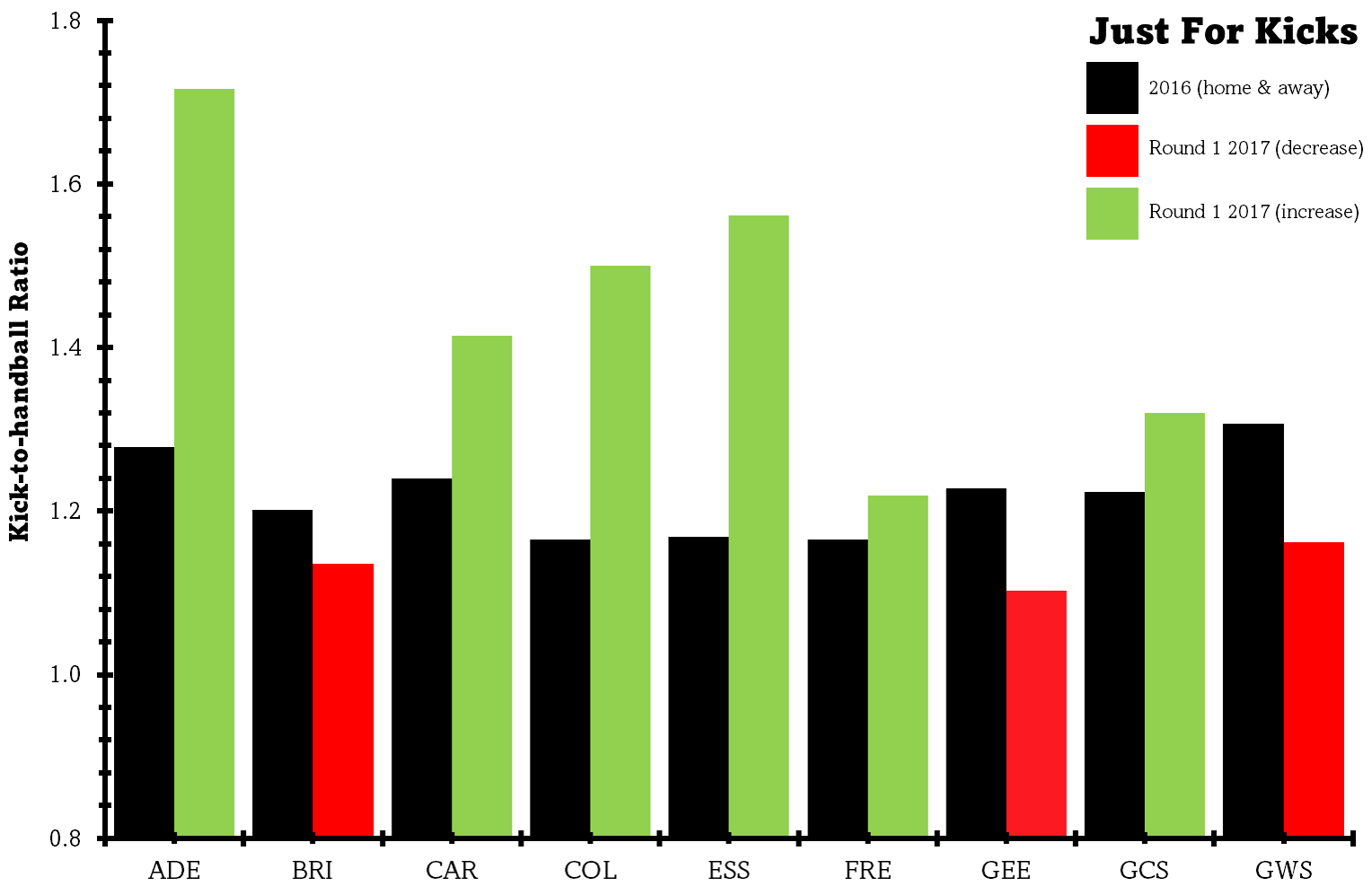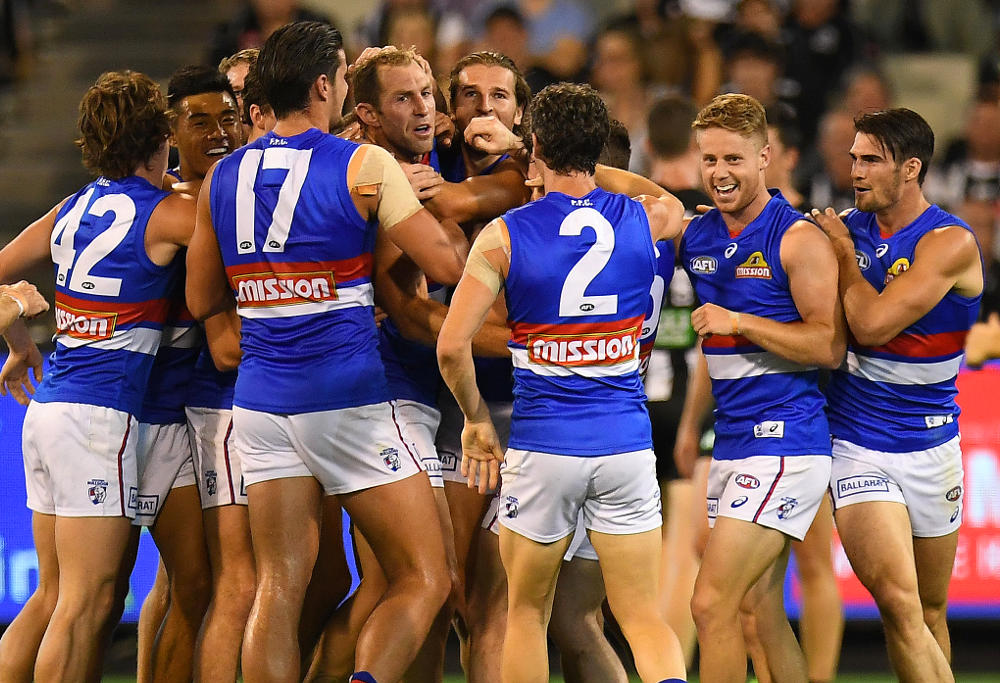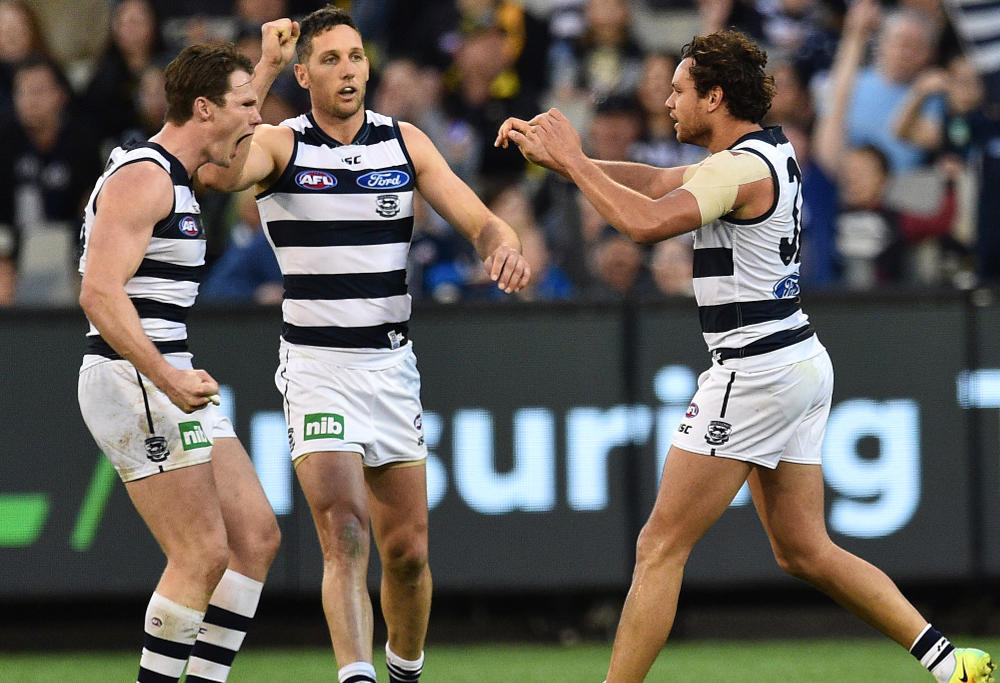It started innocently enough, the first round of the 2017 AFL season. But on Saturday, everything changed. A bonkers Round 1 is a harbinger of the season to come.
Pick your poison: Hawthorn are finished. Sydney’s youth policy has caught up with them. Carlton are going to finish 19th. High scoring football is back. Dustin Martin will win the Brownlow medal. The Giants are soft. Melbourne will finish in the top four. The Saints are still a year or two away. Travis Cloke is the recruit of the year. Port Adelaide are a lock for the finals. The new ruck rules are fantastic. The new ruck rules are terrible. Adelaide are the 2017 premiers. West Coast will be fine without Nic Nat. North Melbourne’s fast football will win them some games. Essendon’s comeback is real. Geelong have developed some depth. Fremantle are going to finish 20th. The Western Bulldogs and Collingwood will finish around the same spot on the ladder. So will Brisbane and Gold Coast, we just don’t know where yet.
You know, all of this could be true. Some of it will prove so. Events transpired across the weekend that mean it is all in play. The promise of 27 weeks of insanity was writ large throughout the summer, and Round 1 delivered it.
The usual torrent of scorching hot takes has followed. To be sure, it is difficult to resist over-reacting to the first taste of premiership football in 172 days.
I can tell you all about that: I helped myself to a generous five full games and three partial games over the weekend.
The only morsel I missed was Port Adelaide’s surprise win over Sydney. The Swans scored 82 points which until Fremantle’s forward line forgot it was supposed to be “new look” looked set to be the lowest score of the round.
Is that a reliable read of where Sydney finds itself? My Football Take Radar (F-AKE-DAR) says ‘no’. The F-AKE-DAR gets a decent work out this time of year, as the football diaspora sorts signal from noise like a woodchipper might search for a needle in a haystack.
There is a time and place for more detailed analysis. Now is not the time, and this column is not the place. Instead, if you’ll indulge me, what follows is some internal dialogue, based on notes taken over the weekend, expound and debated.
[latest_videos_strip category=”afl” name=”AFL”]
Will Melbourne be able to play the rest of the competition the way they played St Kilda?
The biggest football story of the weekend was Melbourne’s pantsing of a pace-heavy St Kilda.
The Saints stormed out of the 2017 gates with an intensity and pressure that became the hallmark of Alan Richardson’s strategy last season, with Melbourne struggling to keep up.
Richardson manufactured a spare man for most of the first quarter, once it became clear Melbourne were trying to play with express pace and long, high kicks inside 50.
Dylan Roberton was the man initially, gathering a ton of marks and dishing off to St Kilda’s fleet of runners.
Melbourne were winning the play at stoppages but were getting zero return. It resulted in a six-goal quarter, St Kilda opening up a 21-point lead.
From there, the adjustments came. Melbourne grabbed the game, got it on their terms, and played with St Kilda for the proceeding 90-odd minutes.
Melbourne were able to translate their dominance on the inside into more spread run as oppose to running in straight lines, moving the ball by foot with remarkable precision.
It shifted St Kilda’s defensive zone backwards and forwards, side to side, and allowed the Dees to get the ball into dangerous positions on the ground.
From there, Melbourne could enter attacking 50 with a choice of short or long kicks to players on the lead, making St Kilda’s spare man redundant.
In the third, the Dees midfield got right on top, with second-year player Clayton Oliver running point at stoppages and dishing out to an endless wave of outside runners.
Jordan Lewis played the link man role, handballing left and right and setting the play with long kicks.
Nathan Jones relished the role of third man, gathering 35 touches and making great decisions.
The maligned Bernie Vince looked at home as an intercepting half back. Melbourne’s personnel meshed with coach Simon Goodwin’s game plan superbly.
At the three quarter time break, Melbourne had translated a 21-point deficit into a 34-point lead. In two quarters the Dees won the ball and kept it off the Saints to such an extent they engineered a nine-goal turnaround.
Over the course of the game, Melbourne won the time in possession battle by close to 16 minutes (the league average for Round 1 was six minutes). The preseason promise of efficient, clean football was met.
Perhaps the sole concern was the Saints managing to put up 90 points on just 43 inside 50s and despite holding on to the ball for only 44 minutes of game time.
The whole AFL world was watching, and Melbourne laid the smack down on what in many quarters was a more fancied opponent. The Dees broke their 15 game losing streak against the Saints in the process. It was a finals-worthy performance.
F-AKE-DAR Assessment: Likely to be true

Hawthorn’s defensive half will be its Achilles heel
Another potentially significant result was Essendon’s comfortable victory over Hawthorn on Saturday night.
While the result itself was significant, it will be impossible to untangle the tangible from the intangible for a few weeks.
The sense of occasion surrounding the game, the noise of the crowd, make it an unusual game to pick apart.
The Dons were rampant, quick, and full of run, a renewed midfield group built on the back of some old stagers but more significantly a trio of relative youth.
Darcy Parish, Zach Merrett and Dyson Heppell will form the core of the Essendon midfield for the next ten years. On Saturday night they had 25, 37 and 34 disposals each. They were involved in six, 11 and 11 scores each. They won eight, 12 and 16 contested possessions each.
Yes, Essendon have Jobe Watson and Brendon Goddard and James Kelly in supporting roles, but the weekend showed the younger guys are already the lead protagonists.
That pace was too much for Hawthorn and their veteran-heavy defence. This is the number one concern for the Hawks and coach Alastair Clarkson coming out of this game.
Hawthorn have made changes in their midfield and forward line in the offseason, but for the most part, their back six is exactly as it was in 2016: Grant Birchall, Josh Gibson, James Frawley and Ben Stratton are the core defenders.
There is some 770 games of AFL experience among that quartet. It showed on Saturday night, with the foursome traipsing about in cement shoes.
The Hawks looked powerless to stop the torrent of Essendon runners entering their defensive 50.
They were beaten on leads, beaten to ground balls, beaten in stationary one-on-one contests.
Essendon scored on 55 per cent of their inside 50 entries, 12 per cent more than the league average for Round 1 and 18 per cent more than the Hawks’ 2016 average.
Taylor Duryea was used as a small defender last year, and he was on the weekend. He recorded just seven pressure acts, according to AFL.com.au, and no tackles – woeful numbers for a small defender, particularly given much of the play was in his area of the ground.
James Sicily looked trapped at sea without a boat, given the presence of the veteran foursome.
As above, it is almost impossible to untangle this particular game. But if as Cam Rose said yesterday the league has caught the need for speed in 2017, and it has, then this looms as a fatal issue for the Hawks, irrespective of how they go up the other end.
F-AKE-DAR Assessment: Danger! Danger Alastair Clarkson!
The competition is not emulating the Bulldogs’ handball-happy stylings
Prior to the season, all the talk was the handball was back in vouge. Cast aside during Hawthorn’s era of dominance, the Western Bulldogs bought it back in a big way.
Their 1.05 kick-to-handball ratio was second lowest in the competition, only beaten by the Paul Roos coached Demons.
The Western Bulldogs also won the 2016 premiership. AFL clubs tend to play follow the leader, and so it was to follow that handballs were set to soar across the competition.
Apparently not, at least not in the first round of the season. The league-wide average kick-to-handball ratio actually increased on last season, from 1.21 to 1.33 – on average, teams went precisely the opposite way of the Dogs.
Here’s each club’s ratio from the last round versus their 2016 season average.


What’s going on? Just seven of the 18 clubs upped their use of the handball in Round 1, and only two of them significantly so (North Melbourne and St Kilda).
There were some big spikes in kicking across the competition: Adelaide had 1.7 kicks for every handball, up from 1.2, for example.
Of keen interest was the Dogs themselves, who recorded a kick-to-handball ratio of 1.39 in their victory over Collingwood, higher than seven other teams.
F-AKE-DAR Assessment: Kicking forever, handballs never

Geelong has found the depth it was missing for most of last season. But at what cost?
Geelong’s biggest off season challenge was to address the team’s reliance on a handful of highly credentialled players.
Patrick Dangerfield, Joel Selwood, Tom Hawkins, Harry Taylor and Corey Enright were the Cats’ most influential players, and while most clubs have a handful of guys driving most of their output, the skew at Geelong was greater than most.
The team simply lacked depth.
It was laid bare in last year’s preliminary final. Dangerfield and Selwood touched the football 39 times each and kicked two goals; the other 20 players touched the ball an average of 14 times and kicked six goals between them.
The pair had half of the team’s clearances, more than a quarter of its contested possession wins, and laid a quarter of the tackles.
Sydney managed to snuff out the already meagre influence of the players not named Patrick and Joel and that was that.
This weekend, the Cats flexed their bottom-20 muscles. Selwood and Dangerfield had 28 and 24 touches, respectively, with Dangerfield in particular spending plenty of time inside Geelong’s forward 50 (as Fox Sports’ Dangercam delightfully revealed).
The maligned Mitch Duncan led the way with 30 touches, playing as a link man in transition and runner at stoppages.
Geelong’s half back line looked solid, eschewing the Enright-or-nothing stylings of last season.
Zach Tuohy’s debut showed he’ll be a weapon off half-back, while Tom Ruggles didn’t start fires in the manner we’ve become used to. Jackson Thurlow made it through his first hit out in two years.
Lachie Henderson and Andrew Mackie formed an impressive intercept marking pair, although doubtlessly enabled by Fremantle’s woeful forward 50 entries.
Jordan Murdoch, George Horlin-Smith and Josh Cowan performed better than their opposite numbers at Fremantle, and while that sounds like a backhanded compliment, it isn’t.
The forward group was refreshingly multi-dimensional, Steve Motlop and Lincoln McCarthy kicked three goals each and provided an unpredictability that was missing last season. Nakia Cockatoo didn’t get much of the ball himself, but was lively and will improve.
In saying that, there are reasons to be wary.
All told, Fremantle’s dumpster fire of an offence was ultimately what separated the two teams. Geelong lost the inside 50 count by eight, and held the ball for a couple of minutes less than the Dockers.
Fremantle’s midfield was able to translate its on-paper strength (Aaron Sandilands, Nat Fyfe, Lachie Neale and Stephen Hill is a fearsome centre bounce combination) to a decisive victory through the middle.
If the Dockers had been more decisive with their forward movements, and played something resembling a 2017 offensive scheme, then the end margin would have been much closer than 42 points.
This disjointedness was likely the result of the Dockers’ personnel. Fremantle’s team was populated by a number of players who hadn’t played together before.
Shane Kersten, Cam McCarthy, Joel Hamling and Bradley Hill were all wearing purple for the first time, while it was the first game Fyfe and Sandilands had played since the team began turning over a number of its veterans in the middle of last season. Plenty of those who survived were playing different roles.
The better performance of Geelong’s team as a collective should be welcomed. But let’s see how that holds up over the next month (Geelong play North Melbourne, Melbourne, Hawthorn, St Kilda and Collingwood in April) before making any grand pronouncements. For now, one game in, the signs were good.
…just get Harry Taylor out of the forward line, please.
F-AKE-DAR Assessment: Too soon to tell but the signs are good

And there’s more…
Adelaide looked immaculate and polished, and should sit well on top of any and all power rankings which have been produced in the days since their demolition of Greater Western Sydney.
That thin midfield you were worried about? It’s not so thin after all – perhaps Adelaide’s good run with injury in 2015 and 2016 simply concealed the makings of a strong list.
The Giants, by contrast, looked out of place. The team clearly missed Stephen Coniglio’s influence through the middle, and didn’t have a clear option to turn to for a negative, accountable role.
It looked as though the football department overthought the match ups at the defensive end of the ground, going with a back six of tweeners instead of picking Nathan Wilson.
Adelaide Oval has been a tough assignment for most teams in recent years, but the manner in which GWS lost was a surprise.
After some early stutters, West Coast imposed their will on the running and gunning North Melbourne.
Their control of the aerial battle was the best of the weekend, albeit the Roos weren’t particularly interested in the high stuff.
By contrast, North have had a clear identity change in the off season – one that will stand them in good stead going forward.
Richmond and Collingwood and the Western Bulldogs and Carlton all played what feels like an eternity ago, and all had reasons to be positive about their respective performances. We see three of the four early doors this round so let’s save judgement on them for now.
The two Queensland sides played an entertaining game, and the only close run thing of the round.
For about 20 minutes there were genuine fears for the coaching career of Rodney Eade writ large over social media, but to the players’ credit they came through in the second half of the game.
Tom Lynch threatened to win the game on his own in the last quarter, an ominous sign for the rest of the competition. Both teams showed they will be no pushover.
That’s it? I think that’s it. Everything we thought we knew about the 2017 AFL season was challenged over the weekend. All that preparation we did, those words we wrote and read, and numbers we crunched, it’s all gone up in smoke. Up is down. Down is left. Left is a banana.
F-AKE-DAR Assessment: It’s Round 1 you dolt, lighten up
Bring on Round 2.


































































































